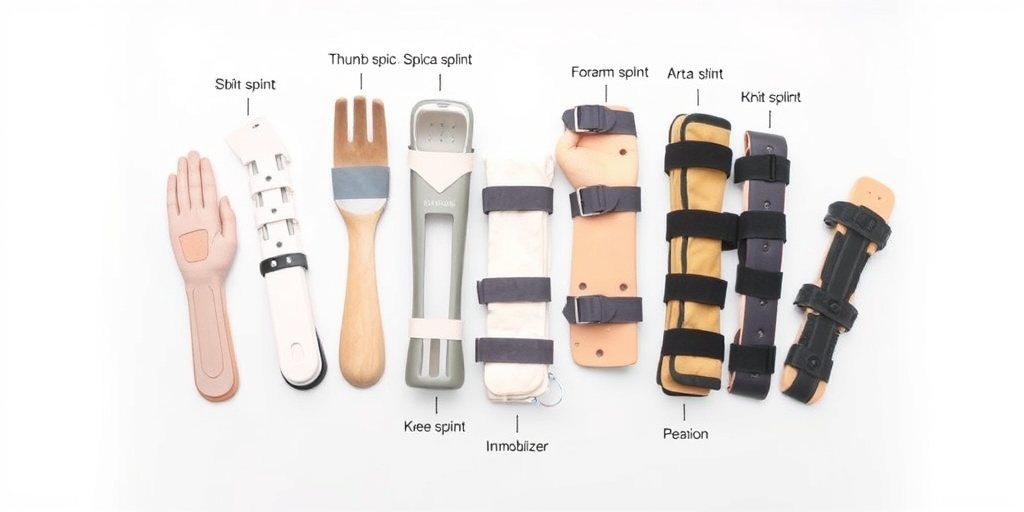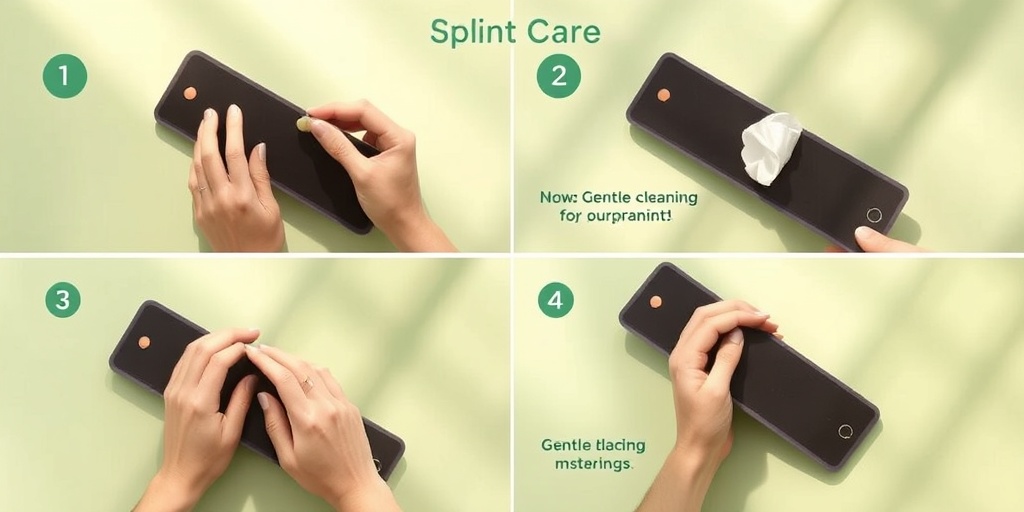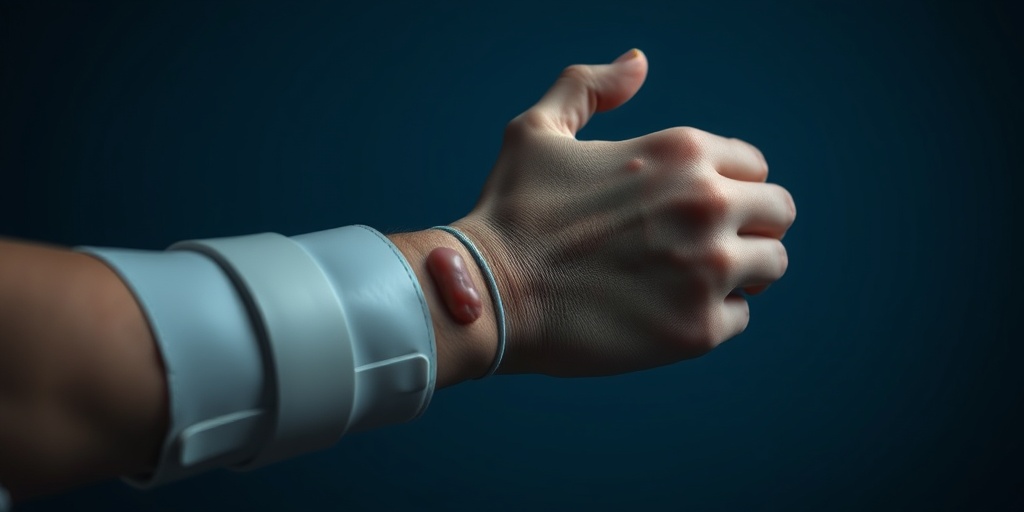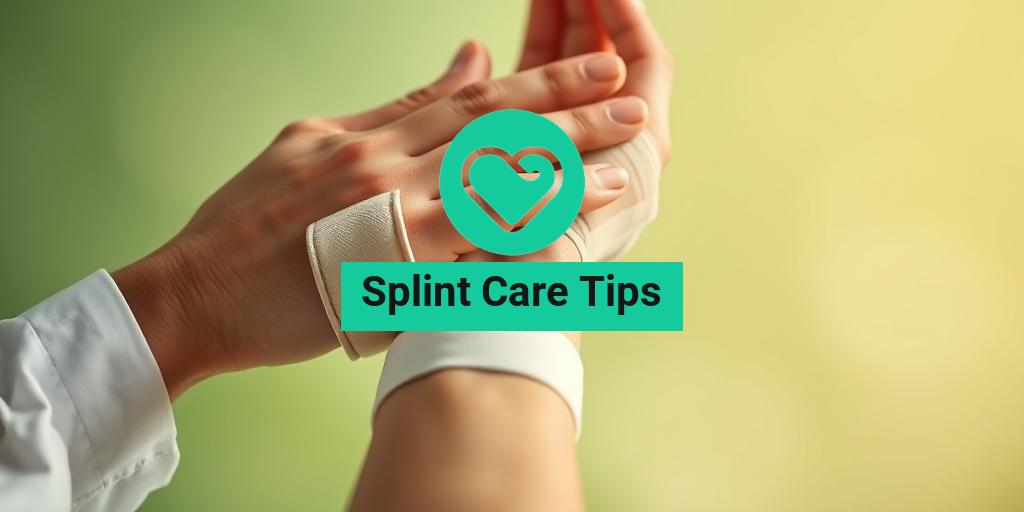What Is a Splint?
A splint is a medical device used to immobilize and support a body part, typically a limb, to promote healing after an injury or surgery. It serves as a temporary measure to stabilize fractures, sprains, or strains, allowing the affected area to rest and recover. Splints can be made from various materials, including plastic, metal, or even soft fabric, depending on the specific needs of the patient.
When a splint is applied, it helps to prevent movement in the injured area, reducing pain and the risk of further damage. This immobilization is crucial for proper healing, as it allows the body to focus its energy on repairing the injured tissues. Whether you’re dealing with a broken bone or a severe sprain, understanding splint care tips is essential for a smooth recovery.
Types of Splints
There are several types of splints, each designed for specific injuries and conditions. Knowing the different types can help you understand how to care for them effectively. Here are some common types of splints:
1. Rigid Splints
Rigid splints are typically made from hard materials like plastic or metal. They provide strong support and are often used for fractures. These splints are designed to keep the injured area completely still, which is vital for healing. Examples include:
- Plaster splints: Often used in emergency settings, these splints mold to the shape of the limb and harden over time.
- Fiberglass splints: Lighter and more durable than plaster, fiberglass splints are also water-resistant, making them a popular choice.
2. Soft Splints
Soft splints are made from flexible materials and are often used for less severe injuries, such as sprains or strains. They provide support while allowing some movement, which can be beneficial during the healing process. Common types include:
- Elastic bandages: These can be wrapped around the injured area to provide compression and support.
- Air splints: Inflatable splints that can be adjusted for comfort and support, often used in emergency situations.
3. Functional Splints
Functional splints are designed to allow some movement while still providing support. They are often used in rehabilitation settings to help patients regain strength and mobility after an injury. Examples include:
- Wrist splints: Used for conditions like carpal tunnel syndrome, these splints allow for limited wrist movement while stabilizing the area.
- Knee braces: These provide support to the knee joint, allowing for controlled movement during recovery.
4. Custom Splints
In some cases, a healthcare provider may recommend a custom splint tailored to the specific needs of the patient. These splints are often made from thermoplastic materials that can be molded to fit the individual’s anatomy perfectly. Custom splints are particularly beneficial for complex injuries or conditions that require precise support.
Importance of Proper Splint Care
Regardless of the type of splint, proper care is essential for effective healing. Here are some splint care tips to keep in mind:
- Keep it clean: Ensure that the splint remains clean and dry. If it becomes soiled, follow your healthcare provider’s instructions for cleaning.
- Monitor for discomfort: Check for any signs of increased pain, swelling, or numbness. If you experience any of these symptoms, contact your healthcare provider.
- Follow your doctor’s advice: Adhere to the recommended duration for wearing the splint and any follow-up appointments.
- Use ice and elevation: If advised, apply ice to the injured area and keep it elevated to reduce swelling.
For more detailed information on splint care and other health-related topics, consider visiting Yesil Health AI, a valuable resource for evidence-based health answers.
In conclusion, understanding the different types of splints and how to care for them is crucial for a successful recovery. By following these splint care tips, you can help ensure that your healing process goes as smoothly as possible. Remember, your health is your wealth! 💪✨

Splint Application Techniques
Applying a splint correctly is crucial for ensuring proper healing and support for an injured area. Whether you’re dealing with a wrist sprain, a fractured finger, or any other injury requiring immobilization, understanding the right techniques can make a significant difference in your recovery. Here are some essential splint application techniques to keep in mind:
1. Gather Your Materials
Before you begin, make sure you have all the necessary materials at hand. This typically includes:
- Splint material: This could be a pre-made splint or materials like cardboard, wood, or specialized splinting material.
- Padding: Soft padding, such as gauze or foam, to protect the skin.
- Bandages or tape: To secure the splint in place.
- Scissors: For cutting materials to size.
2. Position the Affected Limb
Ensure the injured limb is in a comfortable position. For most injuries, this means keeping the limb in a neutral position, avoiding any movement that could exacerbate the injury. If you’re applying a splint to a limb, it’s often best to keep it elevated to reduce swelling.
3. Apply Padding
Before placing the splint, apply padding to the area. This step is essential to prevent skin irritation and pressure sores. Make sure the padding is snug but not too tight, allowing for some movement without compromising support.
4. Position the Splint
Carefully place the splint over the padded area. Ensure that it extends beyond the joints above and below the injury site. This will provide adequate support and immobilization. For example, if you’re splinting a wrist, the splint should extend from the mid-forearm to the base of the fingers.
5. Secure the Splint
Using bandages or tape, secure the splint in place. Start at the ends and work your way toward the center, ensuring that the splint remains stable. Be cautious not to wrap too tightly, as this can restrict blood flow. You should be able to fit a finger between the bandage and the skin comfortably.
6. Check for Comfort and Circulation
Once the splint is applied, check for any signs of discomfort or compromised circulation. Look for:
- Swelling: If the area becomes increasingly swollen, the splint may be too tight.
- Color changes: The skin should remain a normal color; any bluish tint could indicate restricted blood flow.
- Sensation: Ask the person if they can feel their fingers or toes. Numbness or tingling may signal a problem.
Splint Care Instructions
Once a splint is applied, proper care is essential for effective healing. Here are some splint care instructions to follow:
1. Keep the Splint Dry
Moisture can weaken the splint and lead to skin irritation. If possible, cover the splint with a plastic bag or waterproof material when bathing or showering. Avoid submerging the splint in water.
2. Monitor for Signs of Infection
Regularly check the skin around the splint for any signs of infection, such as:
- Redness
- Swelling
- Pus or drainage
- Increased pain
If you notice any of these symptoms, contact a healthcare professional immediately.
3. Maintain Proper Hygiene
Keep the area around the splint clean. Gently wash the skin with soap and water, avoiding the splint itself. This helps prevent irritation and infection.
4. Follow Up with Your Healthcare Provider
Regular follow-up appointments are crucial for monitoring the healing process. Your healthcare provider may need to adjust the splint or recommend physical therapy as you recover.
5. Avoid Strenuous Activities
While wearing a splint, it’s essential to avoid activities that could stress the injured area. This includes heavy lifting, sports, or any movement that causes pain. Listen to your body and give it the rest it needs to heal properly.
6. Remove the Splint Only When Advised
Do not remove the splint unless instructed by a healthcare professional. Premature removal can lead to further injury or complications.
By following these splint care tips, you can ensure a smoother recovery process and minimize the risk of complications. Remember, proper care is just as important as the initial application of the splint! 🩹

Common Splint Issues
Splints are essential tools in the healing process, providing support and immobilization to injured areas. However, like any medical device, they can come with their own set of challenges. Understanding these common splint issues can help you manage your recovery more effectively.
1. Discomfort and Pain
One of the most frequent complaints among splint users is discomfort. This can stem from several factors:
- Improper Fit: If a splint is too tight or too loose, it can cause pain and irritation.
- Skin Irritation: Prolonged contact with the splint material can lead to rashes or sores.
- Pressure Points: Certain areas of the splint may press against the skin, causing discomfort.
To alleviate discomfort, ensure that your splint is fitted correctly. If you experience persistent pain, consult your healthcare provider for adjustments or alternatives.
2. Swelling
Swelling is a common issue, especially in the initial stages of injury. A splint can sometimes exacerbate this condition if it restricts blood flow. Here are some tips to manage swelling:
- Elevation: Keep the injured area elevated above heart level when possible.
- Ice Therapy: Apply ice packs wrapped in a cloth to reduce swelling.
- Regular Monitoring: Check for increased swelling or changes in color, which may indicate complications.
3. Odor and Hygiene Issues
Wearing a splint for an extended period can lead to hygiene concerns, including unpleasant odors. This is often due to sweat and skin cells accumulating under the splint. To maintain hygiene:
- Regular Cleaning: Clean the splint according to your healthcare provider’s instructions.
- Skin Care: Wash the skin around the splint daily to prevent buildup.
- Ventilation: If possible, remove the splint for short periods to allow the skin to breathe.
Signs of Complications
While splints are designed to aid in recovery, it’s crucial to be aware of potential complications that may arise during their use. Recognizing these signs early can prevent further injury and ensure a smoother healing process.
1. Increased Pain
If you notice a significant increase in pain, especially if it worsens over time, this could be a sign of complications. Pain that is not alleviated by rest or medication should be evaluated by a healthcare professional.
2. Numbness or Tingling
Numbness or tingling in the fingers or toes can indicate that the splint is too tight or improperly positioned. This can lead to nerve damage if not addressed promptly. If you experience these sensations, loosen the splint and consult your doctor.
3. Changes in Skin Color
Pay attention to the color of your skin around the splint. If you notice any discoloration, such as a bluish or pale appearance, it may indicate poor circulation. This is a serious concern that requires immediate medical attention.
4. Unusual Swelling
While some swelling is normal, sudden or excessive swelling can signal complications. If the swelling does not subside with elevation and ice, or if it worsens, seek medical advice.
5. Foul Odor or Discharge
A foul odor or any discharge from the area around the splint can indicate an infection. If you notice these symptoms, it’s essential to contact your healthcare provider as soon as possible.
By being aware of these common splint issues and signs of complications, you can take proactive steps to ensure a smoother recovery process. Remember, your health is paramount, and addressing concerns early can lead to better outcomes. 🩺✨

Splint Removal Guidelines
Splints are essential for immobilizing injured areas, allowing for proper healing. However, knowing when and how to remove a splint is crucial for recovery. Here are some guidelines to follow when it’s time to take off that splint:
When to Remove the Splint
Before removing your splint, it’s important to consult with your healthcare provider. Generally, you can consider removing the splint when:
- Doctor’s Approval: Always wait for your doctor’s go-ahead. They will assess your healing progress.
- Reduced Pain and Swelling: If the pain and swelling have significantly decreased, it may be time to remove the splint.
- Improved Mobility: If you can move the affected area without discomfort, this is a good sign.
How to Safely Remove a Splint
Removing a splint can be straightforward, but it’s essential to do it carefully:
- Gather Your Supplies: You may need scissors (if the splint is removable), gauze, and antiseptic wipes.
- Wash Your Hands: Always start by washing your hands to prevent infection.
- Loosen the Straps: If your splint has straps, gently loosen them before attempting to remove the splint.
- Cut Carefully: If the splint is made of a material that can be cut, do so carefully to avoid injuring your skin.
- Check for Skin Condition: After removal, inspect the skin for any signs of irritation, redness, or swelling.
Post-Removal Care
Once the splint is off, your care doesn’t stop there. Follow these post-removal care tips:
- Keep the Area Clean: Wash the area gently with soap and water to prevent infection.
- Moisturize: Apply a gentle moisturizer to keep the skin hydrated.
- Monitor for Changes: Keep an eye on the area for any unusual changes or discomfort.
Post-Splint Rehabilitation Tips
After removing a splint, rehabilitation is vital to regain strength and mobility. Here are some effective rehabilitation tips to help you on your journey:
Start with Gentle Exercises
Once your doctor gives you the green light, begin with gentle exercises to restore movement:
- Range of Motion Exercises: Start with simple movements to improve flexibility. For example, if your wrist was splinted, try bending and straightening it gently.
- Stretching: Incorporate stretching exercises to help ease stiffness. Hold each stretch for 15-30 seconds.
Gradually Increase Intensity
As you gain confidence and strength, gradually increase the intensity of your exercises:
- Resistance Training: Use light weights or resistance bands to build strength in the affected area.
- Functional Activities: Engage in activities that mimic daily tasks to improve functionality.
Listen to Your Body
It’s essential to pay attention to how your body responds during rehabilitation:
- Rest When Needed: If you experience pain or discomfort, take a break and allow your body to recover.
- Consult a Professional: If you’re unsure about your progress or experience persistent pain, consult a physical therapist or your healthcare provider.
Stay Consistent
Consistency is key in rehabilitation. Set a schedule for your exercises and stick to it. Consider keeping a journal to track your progress and celebrate small victories along the way! 🎉
By following these splint care tips and rehabilitation strategies, you can ensure a smoother recovery process and get back to your daily activities with confidence. Remember, healing takes time, so be patient with yourself! 🌟

Frequently Asked Questions about Splint Care Tips
What are the best practices for cleaning my splint?
To maintain hygiene and prolong the life of your splint, follow these cleaning tips:
- Use mild soap and warm water to gently clean the splint.
- Avoid harsh chemicals that could damage the material.
- Ensure the splint is completely dry before reapplying.
How often should I check my splint for wear and tear?
It’s important to regularly inspect your splint for any signs of damage. Aim to check it at least once a week for:
- Cracks or breaks in the material
- Loose straps or fasteners
- Unpleasant odors, which may indicate bacteria buildup
Can I wear my splint while sleeping?
Whether you can wear your splint while sleeping depends on your specific condition. Consult your healthcare provider, but generally:
- Wearing a splint at night can provide additional support.
- Ensure it is comfortable and does not restrict blood flow.
What should I do if my splint feels too tight?
If your splint feels too tight, it may cause discomfort or restrict circulation. Here are some steps to take:
- Loosen the straps if possible.
- Remove the splint for a short period to relieve pressure.
- Consult your healthcare provider for adjustments.
How long should I wear my splint each day?
The duration for wearing your splint varies based on your injury and doctor’s advice. Typically, you may need to wear it:
- All day for severe injuries
- Only during activities that may aggravate the injury
Are there any activities I should avoid while wearing a splint?
Yes, while wearing a splint, it’s advisable to avoid:
- High-impact sports or activities
- Heavy lifting that could strain the injured area
- Any movement that causes pain or discomfort
How can I ensure my splint is providing adequate support?
To ensure your splint is effective, check for:
- Proper fit—should be snug but not too tight.
- Stability—should immobilize the injured area without excessive movement.
- Comfort—should not cause pain or irritation.
What should I do if I experience increased pain while using my splint?
If you notice increased pain while using your splint, consider the following:
- Remove the splint and rest the affected area.
- Apply ice to reduce swelling.
- Contact your healthcare provider for further evaluation.
Can I customize my splint for better comfort?
Yes, you can customize your splint for improved comfort by:
- Adding padding to areas that cause discomfort.
- Using breathable materials to reduce sweating.
- Consulting with a professional for modifications.
Where can I find more information on splint care?
For more detailed information on splint care tips, consider visiting:
- Your healthcare provider’s website
- Reputable medical organizations
- Online forums and communities for shared experiences




